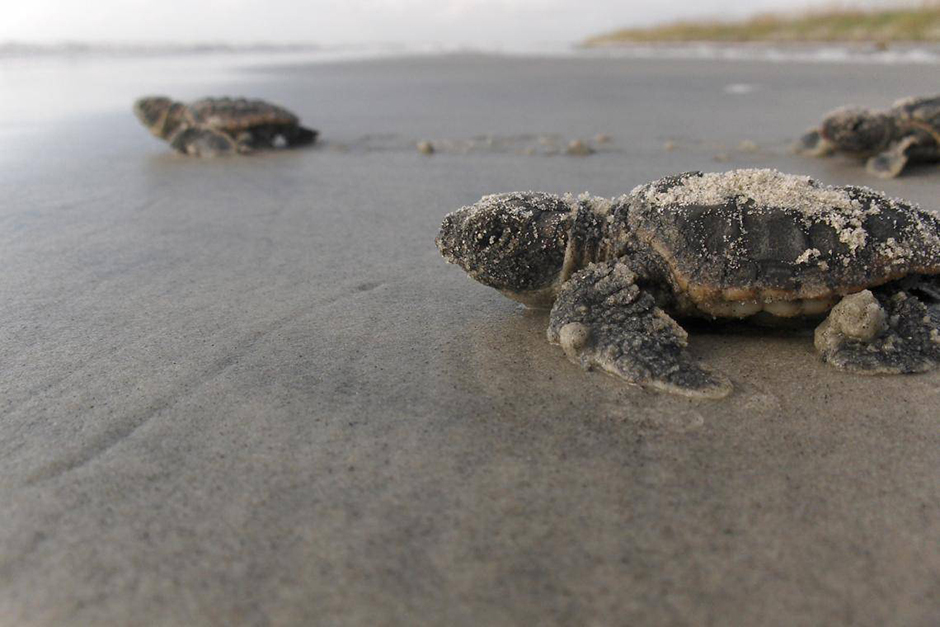
Georgia’s nesting season for loggerhead sea turtles started farther up the coast than usual this week yet still at a most fitting place: Blackbeard Island National Wildlife Refuge.
The annual cycle of these massive turtles returning to beaches in the Southeast to lay their eggs began in Georgia Monday with a single nest on Blackbeard, a barrier island off the northern end of Sapelo Island. The U.S. Fish and Wildlife Service, which manages the refuge, confirmed the nest site Tuesday.
Sea turtle nesting on Blackbeard has been tracked since 1966, one of the longest continuous data sets in the U.S. And while the location of the first nest was unique – Cumberland, the state’s most southern barrier island, usually leads the way – the timing wasn’t. Georgia Sea Turtle Program Coordinator Mark Dodd said first nests “come like clockwork … around the first of May.”
Predicting how the season will go is anyone’s guess. But computer modeling that shows loggerhead nesting tracking a three-year pattern in the region points to a low or medium season of about 2,800 nests, according to Dodd, a senior wildlife biologist with the state Department of Natural Resources.
Georgia set a modern-day record for loggerheads last year with 4,071 nests, the most since comprehensive nesting surveys on all of the state’s barrier island beaches began in 1989. The 2022 count eclipsed the previous high of 3,950 nests in 2019 and produced more than 266,000 hatchlings.
Nesting is documented by the Georgia Sea Turtle Cooperative, a DNR-coordinated network of about 200 volunteers, researchers and agency employees who patrol beaches daily during nesting season.
The loggerhead population has been increasing at approximately 4 percent annually since the early 1990s. However, a population model developed by the University of Georgia and the U.S. Geological Survey using nesting and genetics data indicates the population will plateau at current levels for about the next 15 to 20 years, its progress hindered by low recruitment during the early 2000s, Dodd said.
If current protections remain in place at least through that period, the model suggests loggerhead numbers would then start to increase again, possibly reaching levels not seen since the late 1950s.
Supporting that rebound is the goal of the Sea Turtle Cooperative. Working under a federal permit, members mark, monitor and protect all loggerhead nests, plus those of other species that seldom nest in Georgia, such as green and Kemp’s ridley.
The effort not only eases predation and increases the number of young that hatch, the data collected is used to analyze loggerhead populations, assess threats and inform management. Cooperators also help with beach management. The program has been in play on Georgia beaches for more than 30 years.
“The cooperative has done a tremendous amount of work,” and with a measurable impact, Dodd said. “We started out averaging about 850 nests a year and in the last five years we’re right at 3,000 nests.”
Like other marine turtles, loggerheads – named for their large heads – crawl ashore on barrier island beaches, dig a hole at the base of the dunes and lay their eggs, usually at night.
To prep for the season, Dodd and staff have been training interns, working with volunteers, partner agencies and organizations, and teaming with DNR’s Law Enforcement Division. Game wardens enforce regulations including the use of turtle excluder devices, or TEDs, in commercial shrimping.
The process followed Tuesday morning on Blackbeard NWR will be repeated hundreds of times this year. An egg from each nest – less than 1 percent of the average clutch size – was collected for UGA genetic analysis documenting the number and relatedness of loggerheads nesting in Georgia. The nest was then covered with a screen to protect the eggs from predators.
DNR’s Wildlife Conservation Section works to conserve sea turtles and other wildlife not legally fished for or hunted, as well as rare plants and natural habitats. The agency does this largely through public support from fundraisers, grants and contributions.
Key fundraisers include sales of the monarch butterfly license plates and sales and renewals of bald eagle plate and older designs, such as the ruby-throated hummingbird. These tags cost only $25 more than a standard plate to buy or renew. Up to $20 of that fee goes to help wildlife.
WHAT YOU CAN DO
All marine turtles in Georgia are protected by state and federal law. To help conserve these species:
- Minimize beachfront lighting during sea turtle nesting season. Turn off, shield or redirect lights.
- When walking the beach at night, don’t use flashlights and flash photography. They can deter turtles from coming ashore to nest or cause them to abort nesting.
- If you encounter a sea turtle on the beach, remain quiet, still and at a distance.
- Leave turtle tracks undisturbed. Researchers use them to identify the species and mark nests for protection.
- Properly dispose of your garbage. Turtles may mistake plastic bags, Styrofoam and trash floating in the water as food. After ingesting trash, it can kill them by clogging their intestines.
- Protect beach vegetation: It stabilizes sand and the natural coastline.
- When boating, stay alert and avoid turtles. Of the 84 sea turtles found dead or hurt in Georgia last year, 45 percent that could be assessed had suffered injuries consistent with being hit by a boat. Boaters who hit a sea turtle are urged to stand-by and immediately call DNR at 800-2-SAVE-ME (800-272-8363).
- Also report any dead or injured sea turtles seen at 800-272-8363. (If the turtle is tagged, include the tag color and number in the report if possible.)
Sources: U.S. Fish and Wildlife Service, Georgia DNR
ACCIDENTAL CATCHES
Anglers who hook or entangle a sea turtle should call DNR at 800-2-SAVE-ME (800-272-8363). Also:
- Keep your hands away from the turtle’s mouth and flippers.
- Safely land the turtle using a net or by walking it to shore. Do not lift the turtle by the hook or by pulling on the line.
- Leave the hook in place; removing it can cause more damage. (Anglers are encouraged to use non-stainless, barbless hooks when possible.)
- Keep the turtle out of direct sunlight and cover it with a damp towel.
If an angler cannot reach DNR, cut the line as short as possible and release the turtle.
LOGGERHEADS AT A GLANCE
- Caretta caretta: Most common sea turtle on Georgia’s coast; found off coast year-round. Also one of the world’s largest turtles, topping 350 pounds and sporting a carapace up to 44 inches long. How long loggerheads live is not known.
- Range: The Atlantic, Pacific and Indian oceans, and the Mediterranean Sea. Nests in the U.S. from Virginia to Texas.
- Nesting: Females reach sexual maturity at 30-35 years. From about May through September, they crawl ashore at night, dig a hole in the face of dunes along barrier island beaches, and deposit and cover eggs.
- Pilgrimage: Eggs hatch in 55-65 days. The young scramble for the water, beginning a journey that can take them from sargassum weed off Georgia’s shores to a current-powered loop that circles to the Azores and the eastern Atlantic Ocean, south to west Africa and back to the western Atlantic.
- Eats: Fish eggs and small invertebrates when small. As adults, they eat mainly crabs and mollusks, but also forage items like jellyfish and dead fish.
- Status: Federally listed as threatened since 1978. Georgia DNR reclassified loggerheads in the state from threatened to endangered in 2006.
- Threats: Primarily mortality associated with commercial fishing activities, but also nest predation by raccoons and feral hogs, poaching, loss of habitat, boat strikes, and even ingestion of plastic litter mistaken as food.
FOR MORE
- Georgia nesting updates by beach: http://seaturtle.org/nestdb/?view=3
- Georgia Sea Turtle Cooperative: https://georgiawildlife.com (also on Facebook: https://www.facebook.com/groups/228230141073849)
- Loggerhead profile: https://www.fisheries.noaa.gov/species/loggerhead-turtle
NESTING IN GEORGIA
Annual loggerhead nest totals since comprehensive surveys began in 1989.
1989 – 675
1990 – 1,031
1991 – 1,101
1992 – 1,048
1993 – 470
1994 – 1,360
1995 – 1,022
1996 – 1,096
1997 – 789
1998 – 1,055
1999 – 1,406
2000 – 1,060
2001 – 852
2002 – 1,028
2003 – 1,504
2004 – 358
2005 – 1,187
2006 – 1,389
2007 – 689
2008 – 1,649
2009 – 997
2010 – 1,761
2011 – 1,992
2012 – 2,241
2013 – 2,289
2014 – 1,201
2015 – 2,335
2016 – 3,289
2017 – 2,155
2018 – 1,735
2019 – 3,950
2020 – 2,786
2021 – 2,493
2022 – 4,071
Source: Georgia DNR


Chattooga Schools
GNTC Basic POST Certification graduation held July 22

Bulloch Public Safety
07/25/2024 Booking Report for Bulloch County

Chattooga Schools
Chattooga County Schools: Superintendent Helie’s Welcome Letter

Chattooga Local News
Fall Armyworms Confirmed in Northwest Georgia Counties

Chattooga Schools
Entrepreneur seeks degree at GNTC

Bulloch Public Safety
07/08/2024 Booking Report for Bulloch County

Bulloch Public Safety
07/22/2024 Booking Report for Bulloch County

Bulloch Public Safety
07/02/2024 Booking Report for Bulloch County

Bulloch Public Safety
07/16/2024 Booking Report for Bulloch County

Bulloch Public Safety
07/03/2024 Booking Report for Bulloch County



